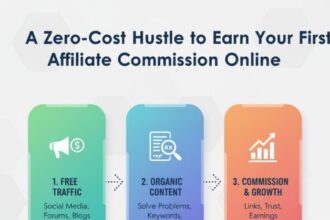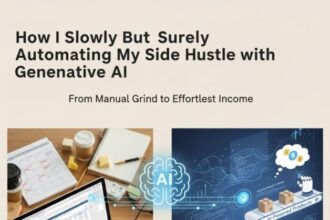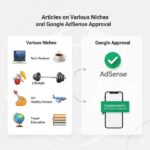How I Accidentally Discovered a Little-Known AI Hack That Makes Me Over $100 a Day
I Wasn’t Trying to Get Rich. I Was Just Tired of Feeling Behind.
I wasn’t looking for a hustle. I was just looking for air.
That kind of financial air where you’re not thinking about the cost of toothpaste or triple-checking your bank app before buying a sandwich.
You know the feeling? I’d gotten into the habit of doing the mental math every time I opened my fridge. And to be honest, that math wasn’t mathing.
Then came that Tuesday night. I was lying on my back, phone practically glued to my face, when I saw a random comment on Reddit.
Something like: “Made $128 today using ChatGPT and a digital product template. Took 45 minutes.”
Honestly? I laughed. One of those sarcastic I’m-broke-but-sure-laughs. But curiosity has a weird way of sneaking into your bones.
So I clicked. Not because I believed it. But because I needed something to believe in. And maybe, just maybe, this could be it.
Falling Into the Rabbit Hole of AI Side Hustles
That one Reddit comment sent me on a 14-day binge.
I didn’t sleep great. I stopped watching TV. I forgot to respond to texts. I just… searched.
And what I found was something between a goldmine and a garbage heap.
Everyone was promising you could earn money online with AI, but 90% of what I saw was either scammy, outdated, or so high-level it might as well have been Sanskrit.
Still, I kept digging.
Eventually, I found real people doing weirdly specific things. Like:
- Using AI to create printable journals
- Selling AI-powered budget planners
- Writing niche Etsy templates with the help of automation tools
Not big-ticket items. Just repeatable, scalable, weirdly effective ideas.
That’s when the idea of passive income with AI stopped sounding like a fantasy and started looking like an actual map.
But I still didn’t know how to read it.
Trying Everything the Wrong Way First
I made every possible mistake. At first, I thought I could just ask ChatGPT to write me a book, slap it on Amazon, and sit back.
So I did it. Wrote an eBook on “daily confidence tips” (I was feeling ironically low on confidence at the time), uploaded it, even made a Canva cover.
I sold three copies. Two were to friends. One refunded. Brutal.
That’s when it hit me. The hack wasn’t in what the AI did. It was in how I used it.
And that’s what changed everything.
The Breakthrough: Treating AI Like a Co-Creator, Not a Robot
Once I shifted my mindset, everything clicked.
Instead of telling the AI to do everything, I started treating it like a brainstorming partner. I gave it my ideas—messy, half-formed, flawed—and let it shape them.
I’d say things like:
“Help me create a 7-day printable mindset tracker for overthinkers.” “What should be included in a financial wellness bundle for people living paycheck to paycheck?” “Can you generate 25 affirmations that feel like a therapist wrote them, not a robot?”
The AI responded. And then I did my thing—editing, adding soul, trimming fluff. That combo? Gold.
And that’s where I finally started to see consistent results. Real ones. I was able to create and sell AI-assisted digital products that felt personal, useful, and actually sellable.
The Real Hack: A Repeatable System That Feels Almost Too Simple
Okay, here’s the blueprint I use now that’s been getting me $100+ daily (sometimes more, sometimes a bit less—but consistent enough to call it reliable).
1. Find a Micro-Niche With a Problem to Solve
Not “people who want to be productive.” That’s too broad.
Think:
- “Burnt-out grad students who love Notion”
- “Mompreneurs juggling 3 kids and an Etsy shop”
- “Remote workers with ADHD trying to meal prep”
Small group. Clear pain point. Use forums, TikTok comment sections, or Etsy search to see what people in those groups are craving.
2. Use AI to Build Solutions at Lightning Speed
Once you pick a niche, prompt the AI to help you generate:
- Printable planners
- Affirmation packs
- Email templates
- Habit trackers
- Guidebooks
- Swipe files
The possibilities are endless. This is where monetizing AI prompts becomes a real thing. You’re not reselling AI’s outputs—you’re shaping them into things people want and need.
3. Edit Relentlessly
This is the difference-maker. Run the AI output through your own human filter. Tweak tone. Add examples. Toss in a bit of humor or honesty.
People don’t buy soulless templates. They buy connection. Even in digital downloads.
4. Package in Canva or Notion
I use Canva for almost everything. And sometimes Notion if I’m making a more interactive planner.
Create simple, aesthetic documents. Think done-for-you checklists, planners, and cheat sheets.
Use free elements. Keep it clean. Don’t overthink it.
5. Sell Through Digital Platforms
I started with Gumroad, then added Etsy and Payhip.
Each platform has its pros:
- Etsy: Built-in traffic but saturated
- Gumroad: Easier payouts, simpler storefronts
- Payhip: Great for bundles and freebies
Use all three. Crosslink them. Build a tiny digital empire one product at a time.
6. Promote Lightly (but Consistently)
You don’t need to be an influencer. Just write honest posts on Instagram, Medium, Reddit, Pinterest—wherever feels comfortable.
You’re not selling a dream. You’re saying: “Hey, I made this helpful thing. If you need it, cool. If not, also cool.”
What I Wish I Knew Before Starting
Let me tell you what no one talks about in all those “AI side hustle” videos.
You’re gonna feel ridiculous at first. Like, deeply awkward. There were moments I stared at my laptop thinking, “Am I really trying to sell a digital confidence journal using a robot’s help?”
And yeah, I was. Still am.
But here’s the thing: we’re all winging it. All those Etsy sellers? The Gumroad people? Half of them learned the same way—through trial, error, and late-night Googling.
The difference is they stuck with it just long enough to get their first sale. Then another. Then ten.
I still remember the exact morning I woke up to 3 new sales. I’d made around $18 while I was asleep.
Eighteen dollars isn’t life-changing. But what it represented? That was electric.
It meant my stuff worked. That I made something useful to someone while doing the dishes and watching reruns.
That’s when I stopped calling it a “little experiment” and started treating it like a quiet revolution.
The Tools That Helped Me the Most
I didn’t use anything fancy. But here are the key platforms and tools I still use regularly:
- ChatGPT (or other similar tools): For idea generation, outlines, rewriting text, or brainstorming new angles
- Canva: For packaging my digital products beautifully (they even have templates made for Etsy sellers)
- Notion: Great for building live, interactive planners or resource hubs
- Gumroad / Etsy / Payhip: The storefronts for selling and automating delivery
- TinyWow / PDF24 / ConvertKit: Random tools that help with converting file types, editing PDFs, and sending emails if you want to grow
There’s no single magic tool. It’s the workflow that matters. AI gives you speed and structure—but your brain? That’s what makes the final product good.
The Emotional Side of All This
Can I get vulnerable with you for a second? There’s something weirdly emotional about making money online, quietly, with no big team or cheer squad behind you. It makes you question everything—like, why didn’t I try this sooner? What else have I assumed I wasn’t “the type” to do?
You start to dream again. But not in that “vision board and manifesting” way. In a grounded way. A I-paid-my-electric-bill-using-something-I-created-from-scratch kind of way.
That hits different. For me, this whole journey opened up possibilities I didn’t even realize were on the table. Not just financially—but creatively. Spiritually, even.
That sounds dramatic. Maybe it is. But it’s also true.
A Few Quick Wins You Can Try Right Now
Before we wrap, here are three rapid-fire suggestions. If you’re reading this and feeling like, “Okay but where do I start?”—try one of these:
✅ Prompt AI to Create a 5-Day Challenge
Pick a micro-topic (like: “Reset Your Sleep Habits”). Use AI to generate a 5-day mini-course. Package as a PDF. Sell on Gumroad for $7.
✅ Build a One-Page Affirmation Pack
Use AI to generate 30 affirmations for a specific person (like: “New moms navigating anxiety”). Format in Canva. Boom—printable download.
✅ Create a Notion Tracker
Ask AI to brainstorm key habits or goals for a type of person (like: “Remote workers with ADHD”). Turn it into a Notion template. Sell it or give it away to grow your list.
None of these take more than an afternoon. But every single one has the potential to become a forever product that makes money while you sleep.
So, Where Does That Leave Me?
Right now, as I finish writing this?
I’ve got three new digital products queued up, a few passive income sales a day ticking in, and a confidence I didn’t have two months ago. Do I still have moments of doubt? Sure. But I also have evidence that says, “You figured something out. And it’s working.”
I don’t think I’m special. I’m just someone who followed curiosity past the point of skepticism. Who gave myself permission to try something “weird” and stick with it.
And look, maybe you won’t make $100+ every day like I do right now.
Maybe you’ll make $20 a week, or $300 your first month.
But that’s real. That’s money from an idea that didn’t exist until you made it.
And if that’s not the coolest kind of alchemy, I don’t know what is.
So go on. Open that AI tool. Ask your first question. Draft your first idea.
Because the only difference between you and the people making quiet money online?
They started.
And now—so can you.











































